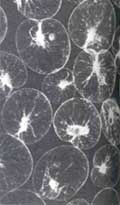Ironing out global warming
Ironing out global warming

WHILE scientists debate the reality of global warming, an extraordinary experiment in the Pacific has dredged up impressive evidence in favour of the seemingly preposterous idea that pumping iron into the sea might stave off the heating of the planet.
The theory is that many parts of the ocean lack iron, which stunts the growth of algae. Pump enough iron, so the argument goes, and the algae will bloom luxuriantly, soaking the atmospheric carbon dioxide -- the chief culprit behind global warming.
Flagged off in November 1993, the year-long experiment, conducted by a team of 40 scientists from the US and the UK, recorded a dramatic increase in the algae's food-making efficiency -- converting light energy into chemical energy -- in 64 sq km of the equatorial Pacific Ocean artificially enriched with iron. Moreover, the amount of chlorophyll doubled and the algal growth, an indication of how quickly the phytoplankton is taking up carbon dioxide, tripled (Nature, Vol 371, No 6513).
Surprisingly, however, this impressive growth did not, as expected, translate into a significant uptake of carbon dioxide by the algae. So while the experiment confirmed that iron could stimulate plankton growth, it did not suggest that a one-time addition of iron would influence atmospheric carbon dioxide concentrations.
Scientists have put forward 2 explanations for this anomaly. First, the ocean patch fertilised with iron may have been overgrazed by zooplankton (microscopic animals that feed on algae), so that carbon dioxide was returned to the atmosphere through respiration and breakdown of organic matter. Second, the iron may have rapidly sunk out of the system.
Nevertheless, spurred by the success of the experiment, scientists are preparing for a second experiment in May this year to solve the puzzles left over from the first.
Meanwhile, the results of another experiment, reported in the journal Nature, point to a strong link between iron, algae and climate. This experiment, conducted in the waters off Antarctica, tested the iron hypothesis by looking at natural levels of algae growth in 2 locations in the ocean -- one with a normal iron concentration and the other with a high iron concentration (Nature, Vol 373, No 6493).
Researchers from the Netherlands Institute of Sea Research and the Alfred Wegener Institute for Polar and Marine Research found that the phytoplankton biomass was an order of magnitude higher in waters with greater iron concentration, leading to less concentration of atmospheric carbon dioxide there.
In the early '80s, scientists studying air bubbles trapped deep in the Antarctic ice sheets discovered a dramatic drop in atmospheric carbon dioxide levels in the last ice age. But no one could satisfactorily explain why this happened. This vexed scientists. They argued that if they could not explain why such changes occurred in the past, how could they possibly predict the way Earth would respond to the extra carbon dioxide that is pumped by humans into the atmosphere everyday?
The iron hypothesis, first suggested in the '20s, was revived in the '80s by the late John Martin of Moss Landing Marine Laboratories in California. He pointed out that there are large parts of the ocean where essential nutrients such as nitrates, phosphates or silicates are in abundance, and yet marine algae are scarce. In these areas, he realised, iron -- which is important for cell growth -- tends to be in short supply.
So Martin suggested that increasing the level of iron could trigger a spurt in algal growth. And because algae absorb carbon dioxide when they make food, more iron would mean more time in the algal kitchen and so less carbon dioxide in the atmosphere.
The idea caused much excitement, but proved hard to test. For one, the first attempts in bottled laboratories failed to replicate the real ocean in all its complexities. For instance, they failed to take into account the grazing of algae by the zooplankton. Furthermore, the turbulence of surface waters made it difficult for the scientists to track the patch of water fertilised with iron.
But in 1993, Andrew Watson at the Plymouth Marine Laboratory and James Ledwell of the Woods Hole Oceanographic Institution in Massachusetts developed a harmless tracer called sulphur hexafluoride, which can be measured in minuscule concentrations and used to track the fertilised patch of water with precision. It was this crucial discovery that made the Pacific experiment such a remarkable success.







